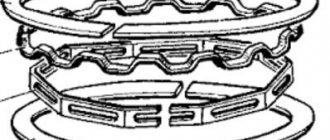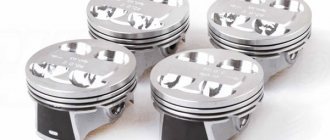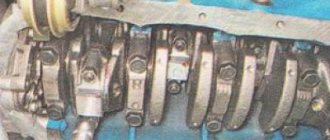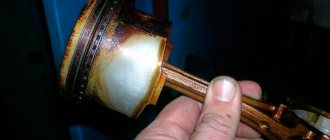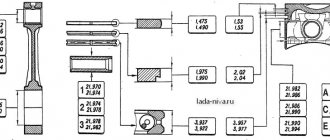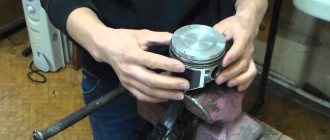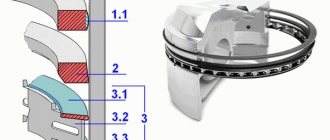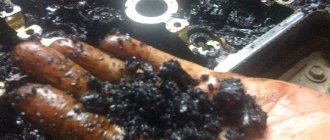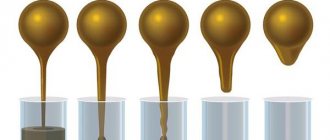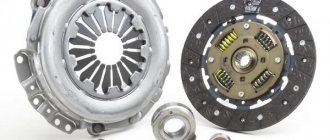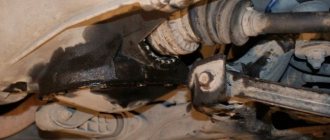Many owners of their “iron horses” are faced with such a problem as engine “fatigue” and its further overhaul. Change the engine to another? No. Not a good idea. You can install the same “tired” one. Therefore, it is better to qualitatively sort out the old one. But there is one “but”...
One of the most important procedures affecting the service life of a vehicle is running in the engine after any repair work related to the replacement of worn parts with new ones. Moreover, this process must be treated no less responsibly than the repair work itself. Run-in is especially important for those engine components whose operation is associated with friction of its parts against each other, and the efficiency depends on the tightness of their fit.
As a rule, the duration of engine break-in is measured by the vehicle's mileage, the length of which directly depends on the nature of the engine repair:
— with minimal intervention (replacing the camshaft, chain, valves, etc.) 500 km is enough for break-in;
— after a high-quality overhaul, in which almost the parts of all the main components are replaced with new ones — 1500-2000 km;
- after a medium repair, when parts in the main components are partially replaced, a longer run is needed for running-in - up to 2500 kilometers.
For example, if the compression and oil scraper rings were replaced, but the pistons and liners remained old. This is due to the fact that new, unworn rings take much more time to “get used” to the old liners and piston grooves on their working surface than to the almost ideal surface of new parts. Therefore, running in the engine after replacing the rings is a mandatory event, which must be carried out in compliance with all the rules that exist for this process.
The main purpose of running in is to smooth out micro-irregularities by rubbing parts against each other to achieve a tight fit. Increased friction during “grinding in” causes increased heating of engine elements. Therefore, during this period, the power unit should operate in a gentle mode, with minimal loads. Below are the basic rules that must be followed during break-in after installing new piston rings on any type of engine.
An important role, which greatly influences the quality of running-in of a repaired engine, is played by its first start.
To carry out the first start of the engine, the battery must be fully charged, otherwise it may not cope with the first start.
For break-in, use only those brands of engine oil recommended by the manufacturer of your car.
In the absence of an electric fuel pump, fuel is pumped manually.
Start the engine and look at the oil pressure warning light located on the instrument panel. If the light does not go out after five seconds, turn off the engine and find out the reason for the low oil pressure. Under no circumstances try to increase the pressure by frequently pressing the accelerator pedal - running the engine in the absence of oil in its components can lead to rapid and irreversible damage to the surface of the rubbing parts.
If after starting the warning light goes out, then everything is fine with the oil pressure.
Warm up the power unit at idle to a temperature of 80-90°C. At the same time, be sure to ensure that there are no leaks of technical fluids. When the engine warms up, turn it off and wait until it cools down to 40-50°C. Then start the engine again and warm it up to 80-90°C again. This procedure must be carried out at least 10 times. Then you can move on to running at higher speeds and hit the road.
Rules for running the engine after replacing rings in road conditions:
- The vehicle should not be fully loaded.
- The speed of movement for the first 1000 km should not exceed 80 km/h, from 1000 to 2000 no more than 90 km/h.
- Shift gears in a timely manner.
- Avoid long climbs.
- Avoid sudden accelerations and prolonged periods of sitting in traffic jams.
- Constantly monitor the oil level.
- It is imperative to change the oil and filter after a run of 1000 km, because wear products appear as a result of the “grinding in” of parts.
- Upon completion of the break-in, it is also necessary to change the oil and filter. In addition, all accessible threaded connections are pulled (block head, oil pan, front cover, starter, generator). If necessary, valves, idle speed, belt tension or timing chain are adjusted.
Compliance with all these simple rules will allow you to properly run-in the engine after replacing the piston rings and ensure reliable operation of the car for a long time.
During the running-in of the engine, a kind of running-in occurs, the parts grind into each other, after which a certain tightness of their fit is formed, which affects the efficiency of the motor.
The duration of the run-in directly depends on the nature of the repair work:
- If the repair was minimal (replacement of the camshaft, valves or chain), the engine is run in for 500 km;
- After a major overhaul with the replacement of the vast majority of engine parts with new ones, it is necessary to break in the engine for at least 1500-2000 km;
- Repairs of average complexity with partial replacement of some parts, running-in takes longer, at least 2500 kilometers. For example, if the compression and oil scraper rings were replaced, the liners and pistons remained old. This is explained by the fact that new, unworn rings require much more time to “get used” to an older piston group than to a completely new “filling” with an ideal surface without wear and tear. It is for this reason that running in the engine after a major overhaul is a mandatory event that must be carried out while adhering to certain rules.
What is engine break-in? In fact, this is the process of smoothing out microscopic irregularities through friction of parts, after which a tight fit occurs between their surfaces, creating pressure in the engine called compression. If during the break-in period the speed is disrupted, then due to the high friction between the surfaces, a high temperature will arise, which will increase the wear of engine elements. During the grinding-in period, the loads on the power unit should be minimal; below I will provide a list of basic rules that must be followed during the running-in of the power unit after replacing the piston rings.
In addition to break-in, the first “post-repair” start of a repaired engine is of great importance; below is a list of measures that must be taken before turning the key in the ignition.
- The battery must be 100% charged; if the battery is discharged, it may not start the engine.
- Fill with the engine oil recommended by your car manufacturer.
- Pump up the fuel; if there is no electric fuel pump, pump in the fuel manually.
- Start the engine. After starting the engine for the first time, carefully monitor the oil pressure indicator light, which is located on the dashboard. If the light does not go out within 5-7 seconds, turn off the engine and start looking for the cause of the low oil pressure.
Attention! Under no circumstances try to cause an increase in oil pressure by applying gas and high speeds, such a first start may be the last, or permanently damage the engine and its parts!!!
- If after starting the engine the oil pressure lamp goes out, the oil pressure is normal, warm up the engine at idle speed to a temperature of 80-90 degrees.
- Closely monitor any smudges and leaks of technical fluids.
- After the temperature reaches the required level, turn off the engine and wait until the temperature drops to 40 - 50 degrees and start the engine again.
- After that, warm it up again to 80-90 degrees. Make at least 10 such circles and only then can you start running in the engine on the road.
How to break in the engine after replacing the rings on the road - instructions
- Do not put any load on the car (cargo, trunk, number of passengers, etc.), the load is maximum 50% of the maximum permissible.
- For the first thousand kilometers, the speed should not be higher than 80 km/h, the next thousand should not be higher than 90 km/h.
- Don’t “stay” for a long time in one gear, switch to higher speed in time.
- Avoid rapid acceleration, as well as prolonged idling (traffic jams).
- Check the oil level regularly, after driving the first 1000 km, replace the engine oil and filter; during break-in, a lot of wear products and small parts of the body in the form of small chips are formed in the engine.
After the engine break-in is completed, replace the oil and filter again, and also check the tightness of the threaded connections (cylinder head, front cover, starter, oil pan, generator). If necessary, you can adjust the idle speed, valves, and timing belt tension.
Follow these tips and recommendations and engine running-in will be successful, and the operation of your internal combustion engine will be stable, reliable and long-lasting.
Text: https://www.autoposobie.ru
You may need to break in the engine after replacing the piston rings. Without this procedure, repairs will simply be useless; you will simply waste time and money. You need to understand that running in is not a whim of mechanics and engineers. This action has a practical meaning and also allows you to significantly increase the service life of the overhauled engine. If you make mistakes during the process, you can get a number of serious problems. It’s more difficult for those who run-in after self-repair. Garage motorists rarely know how to perform the procedure correctly, so situations often occur when the driver has to repeat it soon after repairs. Let's take a closer look at the features of this process, as well as how not to make mistakes when carrying it out. Running in the engine after replacing the piston rings is not a very complicated process, but you need to know how to do this work correctly. You should not listen to folk craftsmen who claim that you can do without this action. Only proper running-in will avoid problems in the future. You also need to take into account that the period and features do not depend on how much the specialist sanded off during grinding. This indicator does not affect the process.
Content
Usually there are two types of running-in. They need to be distinguished. After all, correct use of this procedure can increase the resource by up to 20%. This is a very good indicator that will allow you to save on further engine maintenance. Typically, break-in is understood as a procedure that is performed after a major overhaul of the engine. As a rule, in this case, all the main components are completely replaced, usually only the block and its head are left. In this case, you get an almost new motor. But in order for the parts to get used to each other, a thorough running-in is required. Large services use special stands for the initial procedure. This is impossible in a garage, so you just need to carefully monitor the operating mode of the engine while traveling. Another point is a partial overhaul of the engine.
. This includes the break-in we analyze after changing the piston rings. Here you need to monitor the process a little less, but there are some nuances that simply need to be taken into account. Also, usually in this case, the mileage for grinding in is shorter, which speeds up the process. Below we will consider in more detail all the listed varieties, so you are guaranteed to avoid mistakes after repair.
Before starting the process, you need to carry out a number of actions that are mandatory for any type of work. They are standard and apply in any case. At the very beginning, the following procedures are done:
- Be sure to fully charge the battery;
- After all the above steps, be sure to inspect the engine for leaks of oil, antifreeze and other technical fluids. If we find such a phenomenon, we will definitely eliminate it;
- At the last stages of lapping, strictly follow the manufacturer’s recommendations regarding optimal engine operation during travel.
These rules apply to all types of engine running-in, regardless of what you did in the car. Now let’s look in more detail at the procedure after replacing the piston rings. A mileage of 1,500 kilometers is considered optimal. Moreover, you must immediately drive about 300 kilometers, maintaining 2500 rpm
. It is advisable to do this in third gear. Such a trip will allow you to achieve optimal initial running-in of the rings to the piston and cylinder.
You can drive in the same mode, but not at once. That is, you can freely use the car for business trips, but just do not load it. The last 500 kilometers adhere to the manufacturer's recommended operating mode, but at the same time avoid stressing the engine. After this, the oil and filter must be changed. Then you can safely operate the car in your usual mode.
Over the course of a long period of vehicle operation, almost all motorists are faced with the need to replace piston rings. This procedure is very important for a car, since it directly affects the life of the vehicle. However, the subsequent running-in of the engine after replacing the rings is considered no less important in this matter. This process is not difficult and can be done independently. The main thing is to accurately understand the intricacies of the process and know how to do this work correctly. In this material, we will consider the issue in more detail and try to find out all the nuances of running the engine after replacing the piston rings.
Features of running a scooter after replacing the piston
To give recommendations for running-in after repair, you should first consider the reasons leading to the repair and methods of restoration. After a comprehensive piston replacement, mandatory running-in of the power unit is required. It should be noted that it is not necessary to resort to replacement if any problems arise with the vehicle, be it poor acceleration, lack of normal starting, and so on. Practice shows that there are only two reasons for a comprehensive piston replacement:
- gradual wear of the piston and cylinder, which leads to poor compression inside the combustion chamber;
- the appearance of scuffing inside due to foreign objects getting into the structure, failure of rings, and so on.
To determine the presence of poor compression, it is enough to use a special device - a compression meter. Having discovered that the compression ratio is less than 7.0 atm, you should think about completely replacing the piston group.
What to do if you don’t have a compression gauge on hand? In this case, the check is carried out in the following way. If you think that the moped is difficult to start due to low compression, just pour a little engine oil into the spark plug hole. Having discovered that the engine starts to start better, the absolute cause of the problem is the presence of poor compression in the engine.
What to do if wear occurs?
Having discovered that the problem lies in the failure of the cylinder-piston group (CPG), you can use two methods. The first is to purchase the entire CPG, but this option requires large financial investments. However, the owner will not have to waste time searching for a turner on his own and will be able to complete the replacement procedure without outside help.
On the other hand, if you have an original cylinder, it becomes possible to bore the worn-out one using turning equipment. The procedure is as follows: the owner takes the old cylinder with him to the turner. The specialist visually assesses the condition, after which he indicates the repair size. There are four in total:
These numbers indicate an increase in millimeters to the existing diameter. This amount of metal is ground down during the processing of the inner walls of the cylinder. When boring, the coefficient of thermal expansion of the metal that occurs during engine operation must be taken into account. Therefore, another fifth hundredth of a millimeter (0.05) is added to the indicated number. This will not affect the compression level in any way, and the power unit will not receive a temperature wedge. After assessing the bore diameter, you will have to buy a repair piston. Having purchased it, they pass it along with the cylinder to the master for boring.
Features of removal and installation
First rule. When performing work, it is imperative to maintain cleanliness. Before dismantling the power unit, you should go to the car wash and remove all remaining dried dirt and dust using a high-pressure washer. Using a special cleaning agent, the engine housing is washed. You cannot wash a hot engine, since a sudden temperature change has a negative effect on the engine. Be sure to disconnect the battery. As soon as the body is processed, you need to wait a while until the motor dries out. Using compressed air from the compressor, remove all drops of water, and also treat the wire connections.
When should you perform an engine break-in?
It will not be news to anyone that the installation of any new components on a power unit requires running-in. And here it’s not just about piston rings. After a major overhaul of the motor or immediately after installing a new one, this procedure must be performed without fail. As for the break-in procedure itself, it is intended for only one thing - to determine whether individual components of the power unit are rubbing against each other. When replacing piston rings, this is done to identify violations. Since most parts wear out significantly during operation, when installing a new component it is not always possible to achieve perfect matching of the dimensions of the parts in relation to each other. In other words, running in allows the parts to adjust to each other's dimensions.
Methods for running in the engine
You can properly run in the assembled engine after a major overhaul using stands or during operation. At the service station, engine testing takes place in 3 stages:
- cold running;
- hot running without load;
- hot running with load.
The stands allow you not only to run in the engine, but also to check the quality of repairs. To do this, during the test the following is monitored:
- oil and coolant temperature;
- line pressure;
- crankshaft speed;
- developed power;
- specific fuel consumption.
Run-in is considered complete when the parameters reach a certain range of values and the engine is operating properly:
- at idle speed and at maximum shaft speed;
- evenly in all modes, without sudden knocks and noise;
- there are no oil, fuel or coolant leaks through the connections.
Let's take a closer look at how internal combustion engines are tested in service stations and in garage conditions. The methods are equally suitable for both gasoline and diesel engines.
Run-in on the stand
The stands are suitable for both cold and hot running. The equipment is an installation with an electric motor, control and measuring devices and a cardan shaft for transmitting rotation. The equipment is controlled automatically according to a given program.
The stand is selected according to the engine power. After a major overhaul, the motor is mounted on the unit, lubricant and coolant are added, and the necessary pipes and electrical connectors are connected. The test is completed by inspecting the internal combustion engine:
- remove the pallet;
- inspect the main bearing shells and crankshaft journals;
- If necessary, remove the cylinder head and remove the pistons.
Cold running, unlike hot running, is performed at low speeds of the electric motor, not the motor. The test lasts 20 - 40 minutes with a gradual increase in the rotation speed of the electric motor. During the process they control:
- heating the area where the cylinders and main bearings are located by checking by touch;
- tightness of connections;
- uniformity of engine noise;
- oil pressure and temperature.
Similar article Timing marks for 406 ZMZ engine
For example, KamAZ-740 engines are tested according to the following scheme:
| Crankshaft speed, rpm | Mode time, min |
| 600 — 800 | 20 |
| 1000 — 1200 | 15 |
| 1300 — 1400 | 5 |
To reduce the inspection time by 2 times, low-viscosity oils and special additives are added to the internal combustion engine. This technological technique also makes it possible to reduce metal removal from running-in.
Benchless cold running
This option of cold engine running after overhaul is outdated. The car is attached to a tow rope and pulled in 3rd gear for several hours. This method does not allow tracking individual motor parameters and monitoring its condition.
Hot running
Hot running is the most popular method of testing a overhauled engine. It is carried out on a stand or on a machine with or without a load. Before testing on the stand, spark plugs are installed on the engine, the timing gaps are adjusted, and the power and fuel supply systems are connected. Running in the internal combustion engine is accomplished by rotating the crankshaft, so it is important to monitor the parameters of technical fluids.
During hot running without load, the internal combustion engine is started at a reduced crankshaft speed of 800 - 1100 rpm with a smooth increase in speed. The process takes from 20 minutes to several hours and is completed when half the nominal shaft speed is reached.
For example, the mode for engines ZMZ-405, 406 and 409 is as follows:
| Crankshaft speed, rpm | Mode time, min |
| 850 — 1000 | 5 |
| 1400 — 1600 | 5 |
| 1800 — 2000 | 5 |
| 2300 — 2500 | 5 |
The ZIL-645 test is carried out in 8 stages:
| Crankshaft speed, rpm | Mode time, min |
| 1400 | 10 |
| 1500 | 5 |
| 1800 | 5 |
| 2000 | 10 |
| 2200 | 10 |
| 2400 | 10 |
| 2600 | 5 |
| 2800 | 5 |
For running-in under load, the driveshaft of the stand is connected to the flywheel of the internal combustion engine. The electric motor will act as a generator and load the motor at the same time. The test is carried out with a gradual increase in electric motor power and crankshaft speed in accordance with the technical documentation.
For example, YaMZ-238 is checked according to the following scheme:
| Crankshaft speed, rpm | Load, kW | Mode time, min |
| 1500 | 10 | |
| 1600 | 29 | 10 |
| 1700 | 59 | 10 |
| 1800 | 88 | 5 |
| 1900 | 118 | 5 |
| 2000 | 147 | 5 |
Natural engine running-in
Natural or operational running-in is done without a stand and lasts for 2000 - 3000 km. To properly break in the engine after a major overhaul, you must follow the following rules:
- do not pull trailers, avoid slipping;
- keep the motor in the rotation range of 1500 - 4000 rpm;
- do not coast.
Similar article Engine temperature indicator and sensor on Lada Grant
Operational running-in of the engine involves a gradual increase in load:
- for the first 1000 km it is necessary to keep the speed to 3000 min-1;
- increase the next 1000 km to 3500 min-1;
- after 2000 km - up to 4000 rpm.
It is permissible to give a constant load to the engine after 5000 - 8000 km after repair.
Types of engine break-in
The further operation of the vehicle depends on correctly performed running-in. Depending on the situation, running-in can be of several types:
- After partial engine overhaul;
- After major renovation;
- After replacing components.
After a major overhaul of the engine, running-in is carried out in order to grind in all engine components. It is better to carry out such running-in at a service center where special equipment is available. As for other cases, the running-in must be performed directly on the road, that is, while the car is moving.
First launch after major overhaul
The first start of the internal combustion engine is carried out according to the following scheme:
- Fill in engine oil. It will take 10 minutes for the lubricant to fill the system. The oil filter is left dry to avoid air lock.
- Connect the fuel pump or supply fuel manually.
- Open the throttle manually if there is no automatic drive.
- Start the starter.
- Spin the motor up to 2000 rpm.
- Leave to idle for 15 minutes until engine rotation becomes stable at operating temperature.
- Turn off the unit and wait for it to cool completely.
Similar article: Correctly changing engine oil in a car engine
During startup, the pressure in the lubrication system is monitored. The indicator signal for 4 s indicates incorrect engine assembly. We urgently need to turn off the engine! If the pressure quickly stabilizes, the internal combustion engine is warmed up to operating temperature.
There should be no leaks upon visual inspection. In the first 3 minutes, the engine may knock: the hydraulic compensators are being pumped or the cups are running in. In the future, the sound should become uniform, without vibration. The appearance of a burning smell and slight smoke for the first start is normal - the assembly lubricants are burning through.
If the internal combustion engine is operating stably, start running-in. In order to properly run in the engine after a major overhaul, you need to understand the nuances of the test.
How to break in a chainsaw
A chainsaw is a necessary equipment for working in the garden, in the country and in wood construction. After a purchase or a long break in operation, major repairs and replacement of parts, be sure to run-in the unit before starting up the unit.
Run-in
chainsaws before starting are required to prepare all systems for frequent use. After replacing parts, running-in is necessary in order to fit the new element to the existing mechanisms. This will extend the life of the unit and reduce the number of breakdowns.
After purchasing a chainsaw, the engine especially needs to be run in, since during assembly the parts were not adjusted relative to each other, so the position of each element may allow errors. The break-in process will allow you to accurately adjust the internal mechanisms and parts in contact with each other.
The break-in procedure will require oil. Its choice should be taken very seriously; the instructions for the chainsaw usually indicate which lubricant is suitable for this particular model. It is the oil that creates a special film on the surfaces of parts that come into contact with each other. Lubricated mechanisms function better as a single system and the risk of breakdowns is reduced.
For two-stroke engines of chainsaws, oils of brands recommended by the manufacturer (indicated in the technical data sheet of the product) are excellent; this reduces wear on the cylinder-piston group. When choosing oil for a chainsaw, you should beware of fakes and it is better to opt for a synthetic or semi-synthetic substance (labeled 2T). However, some chainsaw models may have specified recommendations for using a certain type of oil in the accompanying documents.
Proper running-in of a chainsaw. Running in a chainsaw; next oil changes three years after launch. We refuel, check and start!
Modern household chainsaws "Oleo-Mac" developed with the introduction of technologies used for production.
But to accurately carry out running-in of gasoline saws, it is better to use a step-by-step guide, or contact specialists. Representatives will assist not only with putting the tool into operation, but also with many other operations, such as selecting and installing a chain for a chainsaw of the appropriate length, performing repairs, adjustments, and others.
Correct setting of the chainsaw. Preparing a gasoline saw for work
Before you start using a chainsaw, you need to pay attention to several important points:
- installation of the chain;
- preparing the fuel mixture and refueling;
- chain lubrication;
- break-in (in case of working with a new tool).
Proper execution of each step ensures that the chainsaw
will work as expected and will not break the first time you use it.
Sources:
https://opilah.com/kak-pravilno-obkatat-benzopilu/https://proinstrument.com.ua/obkatka-benzopily-i-drugogo-instrumenta-stihl/https://okeydrive.ru/obkatka-dvigatelya- posle-zameny-porshnevyx-kolec/https://termokings.ru/instrumenty/zapusk-i-obkatka-benzopily-posle-pokupki.html
How to extend the life of a new headset?
Experienced sawyers practice keeping a new saw set in a container with hot chain oil at a temperature of no more than 60°C for a day.
This procedure, known as stabilizing the internal structure of the metal, has a positive effect on its resistance to external loads and temperatures. Identical technology is recommended for processing saw sets used as replacement equipment.
During the break-in process, it is necessary to periodically monitor the chain tension, the presence of chain oil in the tank and its supply to the cutting working area. It is better to postpone checking the emergency stop mechanism of the chain until you have developed certain working skills.
Features of fuel preparation
Each chainsaw differs from similar models in terms of design features and dosage of the fuel-oil working mixture, so even if you have the proper experience, it is recommended that you read the attached operating instructions.
To prepare fuel, it is recommended to use fresh gasoline with an octane number of at least 90 and heat-resistant motor oil recommended by the manufacturer, in the dosage specified in the instructions.
The fuel mixture in an amount sufficient for one-time operation is prepared in a fireproof metal container, preferably with a sealed cap. In the absence of oils recommended by the manufacturer, replacement
a full-fledged analogue of the JASOFB or ISOEGB category.
Gasoline with an oil component should not be stored for more than 2 months. The performance properties of an overexposed gasoline-oil mixture deteriorate significantly over time.
Recommendations for the initial break-in stage
- The practice of running in a new chainsaw without a saw set is fundamentally wrong, since all its moving elements need to be broken in.
- The standard break-in time is several hours. In any case, the design of chainsaws of any quality and price level does not provide for prolonged operation of the engine at idle speed.
- In this mode, the loaded parts of the piston
group and connecting rod-crank mechanism experience a significant lack of lubrication, which inevitably leads to overheating and forced wear of the working surfaces. - The total running-in time at idle with periodic gas releases of 25-30 seconds should not exceed 15-20 minutes.
Running a run-in engine without load at high speeds is strictly prohibited. Moreover, running in the tool at idle speed is ineffective; the best result can be obtained when subjected to moderate loads. The new chainsaw can be used to cut wood of medium density and small diameter within 100 mm.
Oil selection and frequency of replacement
It is worth considering in more detail the issue of replacing lubricating consumables after a power plant overhaul. First, this must be done after 500 km. Then after 1000 and the last time after 2000 km. Use high-quality motor oil recommended by the manufacturer. After the specified kilometers have been covered, drain the used mixture and flush the engine. When running in, take into account the oil viscosity:
- in summer 15W40;
- in winter 5W30;
- in the intermediate season: 10
How to properly break in a chainsaw
The service life of new chainsaw equipment largely depends on the quality of its preparation for subsequent operation. How to properly break in a European or Chinese-made chainsaw with maximum efficiency?
The process of running in a new tool, which is low in time and material investment, has a positive effect on its performance characteristics and duration of use.
Moderate loads during the first stage of running-in contribute to the full grinding in of internal parts, the complete and inexpensive development of the designated overhaul and operational service life.
Running in a chainsaw and other Stihl tools
Running in a Stihl chainsaw
The times of the first chainsaws (“Ural” and “Druzhba”) are over in our country. Gone are the days when questions like “How to break in a chainsaw” were relevant. Stihl does not require break-in. At all! No. Even if the guys at the market where you buy it tell you to break it in.
By the way, if you purchase a Stihl tool on the market, this means 99.99999% that you are not buying a Stihl, but a Chinese replica. Firstly, this tool is sold only at official points of sale, through the manufacturer’s website and a few websites of certified partners. Secondly, not a single company manager will tell you that you need to cold start and run in a Stihl chainsaw. Why? Let's look a little more closely below.
How to break in stihl power tools
Proper running in of a CHAINSAW.
Chainsaw
came off the assembly line and was taken to the workshop, where it was assembled, filled with oil and fuel mixture, checked, turned on and…. secured in a special running-in chamber for gas-powered tools, which is located there, at the factory, next to the conveyor. For a regulated time, it undergoes a “hot” run-in until the components and mechanisms are completely ground into each other - in fact, this is the purpose of the run-in and the best way to run in a Stihl chainsaw. Therefore, as soon as you purchase it, refuel and add oil - and immediately go into battle! Work for 10-15 minutes, rest for 5 minutes, then 15-30 minutes, and rest again. After 3-5 tanks of gasoline, it will gain maximum power, and it will be possible to operate for the time specified in the technical passport.
In addition, according to the analogy just described, you cannot break in a Stihl brush cutter, nor break in a Stihl hedge trimmer, nor even break in a Stihl trimmer. Yes, other manufacturers may recommend such a run-in, but in this case, with the Stihl company, it will only be a waste of time and your resources (effort, fuel, oil).
If you want to break in a Stihl tool (be it running in a Stihl gas cutter, running in a Stihl asphalt cutter or something else), we can only recommend running in for grinding in parts that you have changed after a scheduled replacement or as a result of repairs. For example, in a lawn mower the following could be subject to such replacement:
- cutting attachments;
- frame;
- engine belt or wheel drive belt;
- a shaft on which the knives are attached;
- motor.
READ Cleaning the Carburetor of a Husqvarna Chainsaw
How to break in a Stihl lawn mower in this case? Give it gentle work for 30-60 minutes, get rid of particularly tough grass stems and debris, which usually lead to damage.
How to break in a Stihl blower
A leaf blower is also called a garden vacuum cleaner. This is a very convenient tool that in a matter of minutes can get rid of light debris and fallen leaves from a garden plot (usually 30-50 sq.m.). Like other Stihl tools, it undergoes the required break-in at the factory, and therefore there is no need to further break it in. Only in the first days of work give him a reduced load; you cannot immediately put him “into battle” at 100%.
Advantages of factory break-in
It should be noted that new saws from many leading manufacturers do not require running-in. Piston running-in
groups and working equipment using special technology is produced directly in the process of control tests.
Reducing the time of this stage is facilitated by chrome plating the inner diameter of the cylinder and applying wear-resistant coatings to the working surfaces of loaded parts. However, recommendations for a gentle treatment during the first hours of operation of the instrument remain valid.
We repair most brands of power tools and petroleum equipment.
Any new (or after replacing the piston
group) a 2-stroke gasoline engine (which is equipped with your saw, trimmer, etc.) in the first hours of operation requires the so-called “break-in”, on which its further “life” depends. When preparing to start the chainsaw for the first time, you need to carefully read the instructions, taking into account all safety recommendations. The main component of the long service life of your gas-powered tool is oil. Now on the market there are more than a dozen different oils used for 2-stroke engines. The labels contain icons: saw, moped, boat engine. You should be very careful when choosing oil. As a rule, expensive oils are used for mopeds and motorcycles. It is not practical to use them for chainsaws due to their high cost. Some of the most common oils on our market are HUSQVARNA, STIHL, OREGON, PARTNER. These oils have additives that allow them to be used in any climatic conditions and, when mixed with gasoline, to ensure normal engine operation. Modern chainsaws and gas trimmers are designed for 92nd gasoline; it is better not to use 95th gasoline, because it contains too many additives. The operating instructions for 2-stroke gasoline engines indicate that oil and gasoline should be mixed in proportions of 1:50 (usually). This means that 1 liter of gasoline requires 20 grams of oil. It is permissible to mix the first fuel mixture in a 1-liter container with a different proportion (1 liter of gasoline and 25 grams of oil). This will allow for more enhanced lubrication of the engine mechanisms during the first hours of engine operation. In this case, smoke will be observed from the exhaust pipe. There is an opinion that in the first hours of operation the saw should operate at idle speed (i.e. without accelerating) for several hours and only then can it be used for cutting wood. We recommend that when you first start the saw, let it run for about five minutes and, observing safety rules, begin cutting small branches and trunks of about 100 mm, while working at medium speed. It is not recommended to overload the saw engine in the first minutes, allowing the chain to get stuck or the engine to stop. since under increased load, a new engine may experience “burrs” in the working cylinder, which ultimately leads to its failure. Advice: Never mix more gasoline with oil than you can produce within 2 weeks, as the properties of oil diluted with gasoline are lost. Tip: Do not use unknown oils. The label must state "Two-stroke engine oil." Advice: Do not transfer your gas-powered tool to another person without consulting him on safety precautions and rules for mixing oil “1 liter of gasoline. 20 grams of oil”
Preparing for the first launch
Before starting the chainsaw, you must make sure that the emergency stop mechanism of the headset is turned off. The engine is started in the sequence recommended in the instructions.
After a short warm-up, it is recommended to bring the power unit to medium speed to check the lubrication system. To do this, just hold the headset over a sheet of paper. The presence of an oil streak indicates the serviceability of the system and complete lubrication of the saw chain.
The bearings of the driven sprockets of guide bars with a length of 16 inches or more are individually lubricated after 8-10 hours of operation.

